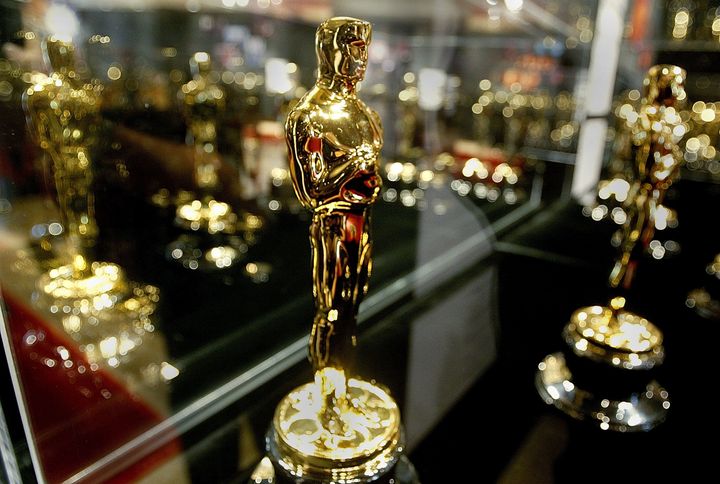
The countdown to the 90th Academy Awards is almost over, which means you might have some questions about the big night.
Of course, everyone wants to know who will take home the trophies on Sunday, but we can’t help you with that. We can, however, fill you in on some fun details about what many consider the biggest night of awards season, from what the statuette is made out of to whose names are popular when it comes to acceptance speeches. Here are seven facts below.
The statuette has an official name, and we’re not talking about Oscar.
The trophy given out at the big show is actually called the Academy Award of Merit, but it’s known as an Oscar. Why? No one really knows. According to the Academy of Motion Picture Arts and Sciences site, there’s a theory that a librarian and later executive director for the academy noted that the statuette resembled her uncle named Oscar. The nickname wasn’t officially associated with the trophy until 1939 despite it gaining popularity years earlier, thanks to a story that discussed Katharine Hepburn’s past Best Actress win.
The award is 13 1/2 inches tall and weighs 8 1/2 pounds. It shows a knight holding a sword, standing on a film reel with five spokes. The spokes represent actors, directors, producers, technicians and writers.
The trophy is made up of solid bronze and plated in 24-karat gold ― except for three years in which there was a metal shortage because of the Second World War and the trophies were made of plaster. Don’t worry: Winners were able to trade them out for the regular trophies after the war.
The academy credits Cedric Gibbons, chief art director at Metro-Goldwyn-Mayer, as the statuette’s designer and artist George Stanley as the sculptor. It takes about three months for 50 statuettes to be made.
This year, there are about 140 pieces of music that the orchestra must be prepared to play.
The show’s musical director, Harold Wheeler, told HuffPost that he handpicks his orchestra players “for their proficiency, for their versatility.” Wheeler and his musicians must be ready to play a variety of music, including hip-hop, pop, rock ‘n’ roll and scores from Hans Zimmer and John Williams. Although the orchestra must know more than 100 pieces, only a fraction of them are played.
There used to be awards specifically for young performers.

In the 1930s, Shirley Temple was the first performer to receive the Academy Juvenile Award, a mini Oscar trophy given to young stars to recognize their talent. As The Hollywood Reporter noted, the award relieved the stress for those who thought having a child compete with adults was awkward and inappropriate. It wasn’t given out every year like the usual awards, since there wasn’t always a contender to receive it. The academy stopped giving them out in 1962.
Ties can actually happen.
There have been six ties in the history of the Oscars. Being within three votes of the winner used to constitute a tie, but the academy changed the standards by 1950 so that an actual tie is necessary to give out the award to more than one contender.
As HuffPost senior entertainment reporter Leigh Blickley noted:
According to a source close to the academy, 23 out of the 24 Oscars categories are tabulated using a “winner-takes-all” system, meaning the person or movie with the most votes in each category wins ― period. If two or more nominees achieve this with the exact same number of votes, they all become winners.
Yep, that means there could be a three-way, four-way, or even five-way tie, depending on the number of nominees. Read more about the nomination and voting processes and the possibility of a tie here.
Someone once won an Oscar without even being included on the ballot.
In the 1930s, Hal Mohr became the first filmmaker to win an Oscar via write-in vote (for his cinematography work on “A Midsummer Night’s Dream”). No one else has been given the opportunity for such an achievement, as the academy did away with the practice for its next award show.
Mohr didn’t need it, though: He later won another Oscar for his work on “Phantom of the Opera” in 1943.
Meryl Streep is a popular person to mention in acceptance speeches.

According to Slate’s deep dive into actors’ Oscar acceptance speeches, Meryl Streep is one of the most popular people to thank. In a comparison done in 2014, of 47 speeches given in the last 12 years, she even beat out God for the coveted honor of being thanked most frequently in other people’s speeches. Oprah Winfrey and Sidney Poitier were not far behind.
That same year, Slate found that actresses more frequently give a shoutout to the academy first compared to actors, and giving thanks to your agent first is actually more rare than you’d think.
An Oscar isn’t actually worth that much. Kind of.
The academy has official regulations regarding the sale of its awards. They include the stipulation that a winner cannot attempt to sell or “dispose” of the statuette without “first offering to sell it to the Academy for the sum of $1.”
What if you’re an heir and you want to try it? Too bad. The rule applies to you, too.
Better luck next time, winners.
